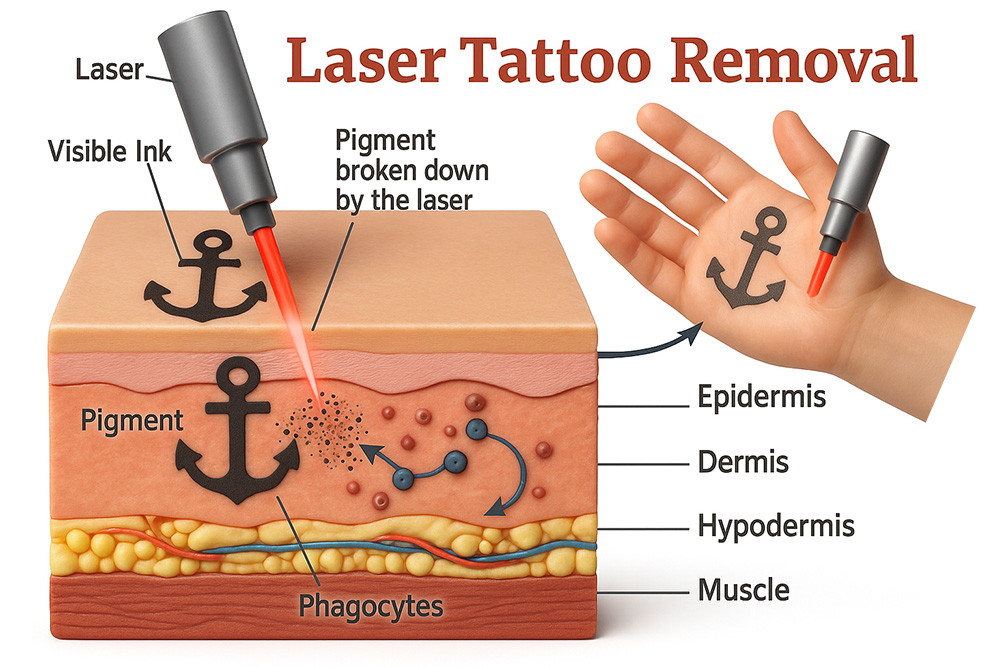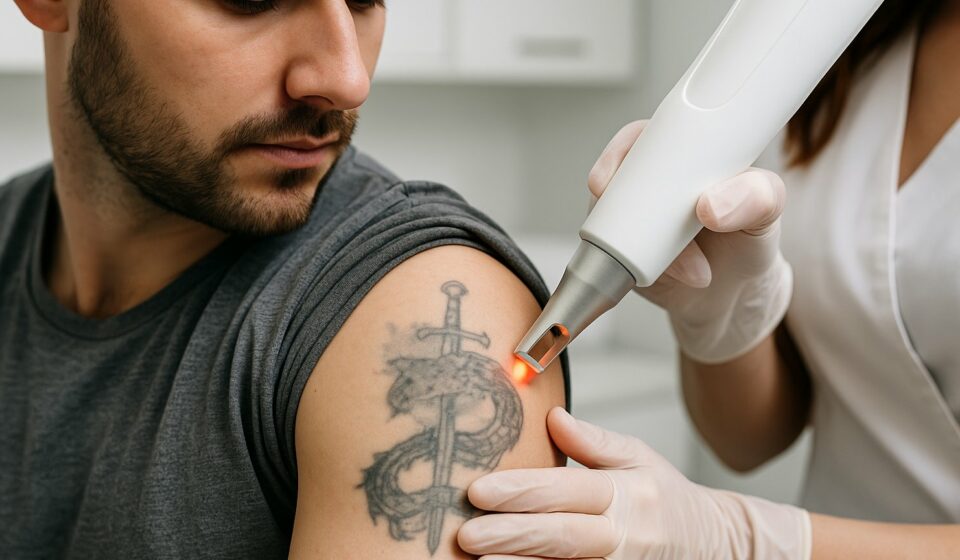Most professional laser courses fade tattoos by sixty to ninety five percent, sometimes more, though complete clearance is not guaranteed for every colour or skin type. Real results depend on ink chemistry, density, skin tone, device quality, spacing, and aftercare. Here is a practical, no fluff guide to what actually fades and why.
Table Of Content
How lasers lift ink
Q switched lasers deliver very brief pulses that ink absorbs strongly. Energy turns to a photoacoustic effect that fractures particles, then your immune system clears the debris between visits. Black pigment at 1064 nanometres usually responds best. Reds respond at 532 nanometres. Greens and blues can be stubborn and may need more sessions. A concise explainer of the mechanism appears in JAMA Dermatology.
01. Typical fading by stage
| Milestone | Typical fade range | Notes |
|---|---|---|
| After 1 to 2 sessions | 10 to 30 percent | Shading softens first. Outlines look sharper by contrast. |
| After 3 to 4 sessions | 30 to 60 percent | Patches of skin tone show through, dark fills break up. |
| After 6 sessions | 60 to 80 percent | Common point for cover up readiness on many black designs. |
| After 8 to 12 sessions | 80 to 95 percent | Dense outlines and certain colours can linger as a shadow. |
Yellow, white, and some bright pastels may never vanish fully. That is a known limitation noted by WebMD.
What increases the odds of a stronger fade
- Colour and chemistry: black clears fastest. Reds often fade well. Blues and greens vary and may need extra sessions.
- Density and layering: professional, multi layer pieces and cover ups hold more pigment per square centimetre, so they take longer.
- Tattoo age and depth: older, sun faded ink tends to lift more readily than fresh, dense work.
- Location and circulation: upper body zones often clear quicker than ankles or hands.
- Device and operator: high energy, stable Q switched Nd:YAG with correct spot sizes and expert endpoints deliver steadier progress.
- Spacing and aftercare: six to eight week gaps are common to allow immune clearance. Follow aftercare to avoid delays.

02. What full removal really means
- Clinical reality: full clearance is possible for many black line designs, yet some colours leave a faint shadow.
- Skin type matters: darker skin tones are treated conservatively to protect pigment. This can lengthen the course, though modern Nd:YAG at 1064 nanometres is designed for safety on deeper tones.
- Scarring risk today: low with proper technique and aftercare. Temporary redness, swelling or blistering can occur and usually resolves, as reflected in the NHS guidance.
Cover up readiness versus total clearance
Not every client needs a blank canvas. Many artists ask for sixty to eighty percent fade so the new design sits cleanly. This reduces time and cost compared with attempting to erase every trace of the original. If cover up is your goal, say so during consultation and your plan can be tuned for faster readiness.
03. Session planning that works
- Start with a patch test: confirms your response and the correct settings.
- Book spaced sessions: six to eight weeks is a good rhythm for most areas. Longer gaps may help with very dense colour work.
- Follow aftercare: keep it clean and dry for the first days, avoid heat and sun, and use simple emollients only.
Devices that consistently deliver fade
For reliable clearance across black and most colours, clinics favour Q switched Nd:YAG with both 1064 and 532 nanometres. Our Nu Tatouage Plus offers high pulse energy, dual shot counters, and low running cost which supports fair pricing for clients. Add the Cryo 6 for extra comfort.
- See it live: prefer a walk through. Book a demo in Coventry or virtually.
- Spec and finance: request packs and ROI sheets via request details.
- Learn the process: read our step by step explainer on how laser tattoo removal works.
Quick answers
- How much will mine fade: black single colour designs commonly reach eighty to ninety five percent with a full course. Multicolour, dense or layered pieces can sit in the sixty to eighty five percent range.
- How many sessions: six to twelve is standard. Some pastels need more. Spacing is essential for clearance and skin recovery.
- Will it scar: scarring is uncommon with modern Q switched systems and trained practitioners, especially with sound aftercare.
04. The smart way to set expectations
- Be specific: declare full removal or cover up fade as your goal during consultation.
- Stay consistent: keep to your schedule and follow aftercare to avoid setbacks.
- Choose proven tech: dual wavelength Nd:YAG with high pulse energy speeds fading and reduces repeat passes.
With good planning, an experienced operator, and a capable device, tattoos can fade far further than most people expect. The exact number for your piece is personal to its colour mix, density, placement, and response, yet steady, measurable fading is very achievable for the vast majority of clients.
Dr Majid Zarandouz
Majid holds a PhD in organic chemistry and has been working with laser systems for decades. His career began in the mid-1990s, when he started researching and developing laser-based technologies for medical and cosmetic applications. Over the years, he has combined scientific expertise with practical engineering to design machines that are effective, durable, and straightforward to use in real clinic settings. As director of the British Institute of Lasers, Majid continues to focus on producing equipment that meets professional standards while remaining accessible to businesses of all sizes.

